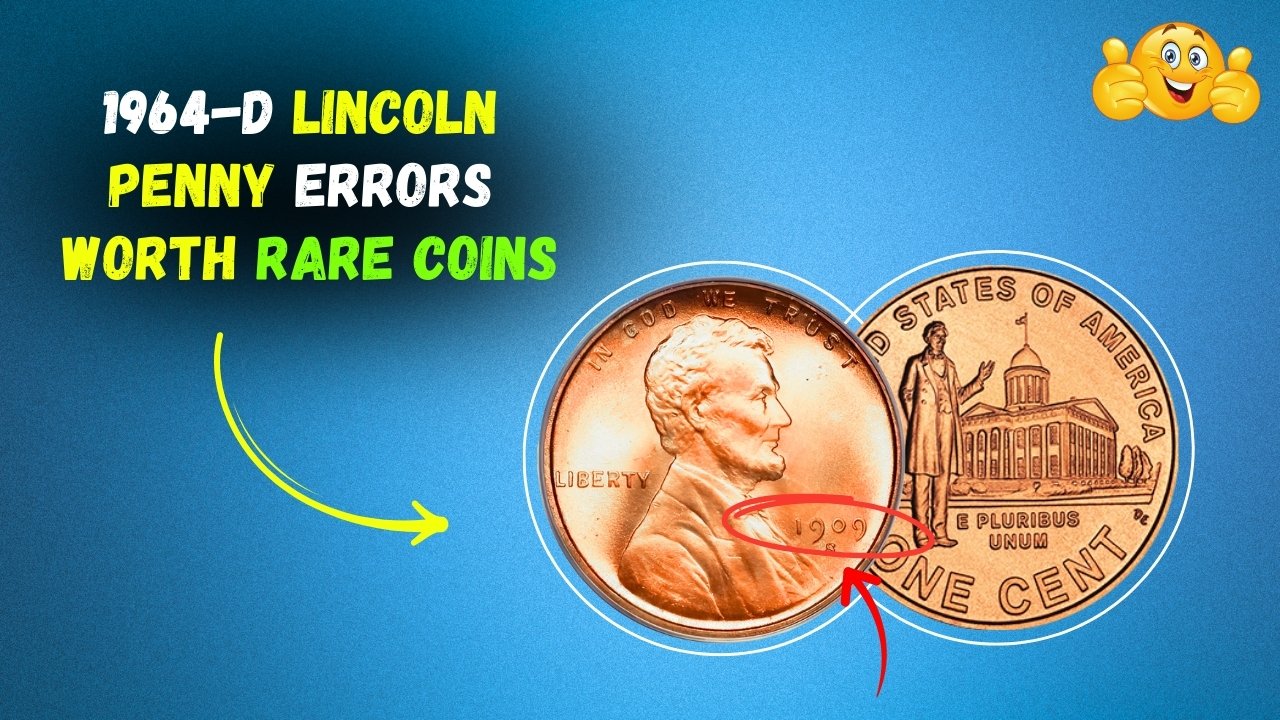Join on WhatsApp
Get the latest updates directly on WhatsApp – motivation, news & more!
Coin collecting has always been a fascinating hobby for people who enjoy history, rarity, and the thrill of discovering hidden treasures in everyday change. One of the most talked-about coins among collectors is the 1964-D Lincoln Penny. While most pennies from this era are only worth their face value, certain rare error varieties can be worth thousands of dollars today. Knowing what to look for in your pocket change or old coin jar could mean stumbling upon a small fortune.
Background of the 1964-D Lincoln Penny
The Lincoln cent, first introduced in 1909 to honor President Abraham Lincoln’s 100th birthday, has remained one of the most collected coins in U.S. history. By 1964, the penny was still being struck in a composition of 95% copper and 5% tin and zinc. The “D” mint mark indicates that the coin was minted in Denver, Colorado. Millions were produced that year, making the standard 1964-D penny quite common. However, errors during minting have created a number of rare variations that collectors eagerly seek.
Why Error Coins Are Valuable
Error coins are created when mistakes occur during the minting process. These mistakes might involve doubling of the design, misaligned dies, off-center strikes, or incorrect planchets. Because such errors are rare, they can increase the coin’s value dramatically. The uniqueness of each error makes it appealing to collectors, and demand for these unusual coins often drives up their prices.
Common 1964-D Lincoln Penny Errors to Look For
Double Die Obverse
One of the most valuable errors associated with the 1964-D Lincoln penny is the doubled die obverse. In this variety, the design elements on the front of the coin, such as the date or the inscriptions “LIBERTY” and “IN GOD WE TRUST,” appear doubled. This doubling occurs during the die-making process and can be very noticeable with the naked eye or under magnification. Collectors are willing to pay high premiums for well-defined doubled die examples.
Repunched Mint Mark (RPM)
In the 1960s, mint marks were punched into the dies by hand. This sometimes resulted in the mint mark being struck more than once, slightly misaligned. A repunched “D” mint mark on a 1964-D penny is a recognized error and can raise the value of the coin significantly. Some examples show a clear shadow or outline of another “D” under or beside the main mint mark.
Off-Center Strikes
An off-center strike occurs when the coin blank is not properly seated in the coin press. This causes part of the design to be missing or shifted toward the edge. Depending on how far off-center the strike is, the coin can become highly collectible. A 1964-D penny with an off-center strike of 10% or more can fetch a strong premium, especially if the date is still visible.
Die Cracks and Cuds
Another error type is die cracks, which appear as raised lines on the coin caused by a damaged die. A cud error is a more dramatic version, where a portion of the die breaks off completely, leaving a raised blank area on the coin. While not as rare as some errors, dramatic die cracks and cuds on a 1964-D penny can still add value.
Wrong Planchet Errors
Though extremely rare, some 1964-D Lincoln pennies may have been struck on the wrong planchet. For example, if a penny was accidentally struck on a dime or foreign coin blank, the result would be a very rare and valuable error. Coins like these can sell for thousands of dollars at auctions.
How Much Can a 1964-D Error Penny Be Worth?
The value of a 1964-D Lincoln penny with errors depends on the type of error, its visibility, and the overall condition of the coin. While a standard 1964-D penny is worth just one cent in circulation, error varieties can command impressive prices:
- Doubled die obverse: $500 to $3,000 depending on clarity and condition
- Repunched mint mark: $50 to $500
- Off-center strikes: $100 to $1,000 depending on percentage off-center
- Dramatic die cracks and cuds: $20 to several hundred dollars
- Wrong planchet strikes: $5,000 or more in rare cases
Auction records have shown collectors paying thousands for pristine or dramatic examples of 1964-D error pennies.
Tips for Identifying Error Pennies
If you suspect you might have a valuable 1964-D penny, here are some steps to take:
- Examine with magnification – Use a jeweler’s loupe or magnifying glass to look closely at the date, lettering, and mint mark.
- Check alignment – Look for off-center strikes or misaligned designs.
- Look for doubling – Notice if any letters or numbers appear doubled.
- Inspect for cracks or blank areas – Raised lines or missing portions of the design may indicate die damage.
- Get professional grading – Submitting the coin to a professional grading service like PCGS or NGC can confirm authenticity and help determine value.
Why Collectors Love the 1964-D Penny
For many collectors, the 1964-D penny represents an exciting opportunity to uncover hidden value in everyday change. It’s a coin that is still commonly found, yet the possibility of finding a rare error keeps the thrill alive. Unlike some rarer coins that are nearly impossible to come across, the 1964-D penny is accessible, making it a favorite among both beginner and advanced collectors.
Conclusion
The 1964-D Lincoln penny may appear ordinary at first glance, but hidden among millions of regular coins are error varieties worth thousands of dollars. From doubled dies to repunched mint marks and rare off-center strikes, these mistakes from decades ago have turned a simple one-cent piece into a potential treasure. If you happen to find one of these error pennies in your change, you might be holding more than just a coin—you could be holding a piece of history with significant value.

